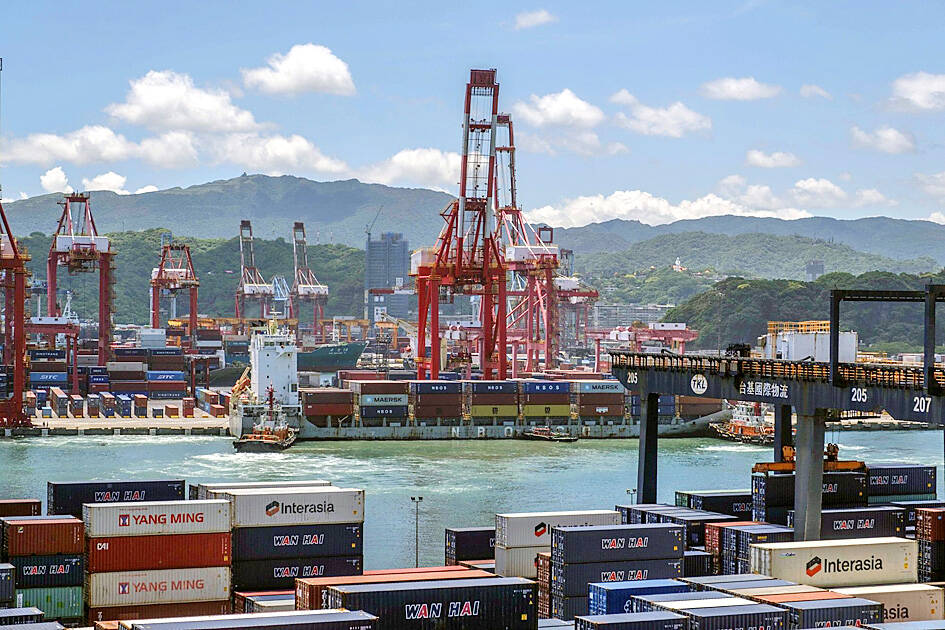The nation’s economy continued to show signs of a slowdown, with the index of leading indicators for last month falling 0.94 percent to 96.38 points from July, marking the 10th consecutive month of decline, the National Development Council said yesterday.
The index is used as a gauge for the economy’s direction in the coming six months. Among the index’s seven components, only the readings on imports of semiconductor equipment and net accession rate of employees made a positive contribution last month, the council said in a report.
Five other components — manufacturing sector, export orders, the TAIEX, floor area of building permits and real M1B money supply — weighed on the composite index, it said.

Photo: Lam Yik Fei, Bloomberg
Last month’s index of coincident indicators, which tracks the current pace of economic activity, decreased by 1.43 percent to 96.89, falling for a seventh consecutive month, the report showed.
All seven components of the index fell from the previous month, the council said.
Apart from slowing industrial production, exports and capital equipment imports, power consumption, retail sales and wholesale trade also weakened, it added.
The total score of monitoring indicators for last month was 23 points, down from 24 points in July, flashing a “green light” for a sixth consecutive month, implying steady growth, the report showed.
The council uses a five-color spectrum to gauge economic health, with “blue” signaling recession, “green” suggesting steady growth and “red” indicating overheating. Dual colors mean it is in transition.
The government will be closely monitoring the economic situation, the council said in the report.

The Eurovision Song Contest has seen a surge in punter interest at the bookmakers, becoming a major betting event, experts said ahead of last night’s giant glamfest in Basel. “Eurovision has quietly become one of the biggest betting events of the year,” said Tomi Huttunen, senior manager of the Online Computer Finland (OCS) betting and casino platform. Betting sites have long been used to gauge which way voters might be leaning ahead of the world’s biggest televised live music event. However, bookmakers highlight a huge increase in engagement in recent years — and this year in particular. “We’ve already passed 2023’s total activity and

BIG BUCKS: Chairman Wei is expected to receive NT$34.12 million on a proposed NT$5 cash dividend plan, while the National Development Fund would get NT$8.27 billion Taiwan Semiconductor Manufacturing Co (TSMC, 台積電), the world’s largest contract chipmaker, yesterday announced that its board of directors approved US$15.25 billion in capital appropriations for long-term expansion to meet growing demand. The funds are to be used for installing advanced technology and packaging capacity, expanding mature and specialty technology, and constructing fabs with facility systems, TSMC said in a statement. The board also approved a proposal to distribute a NT$5 cash dividend per share, based on first-quarter earnings per share of NT$13.94, it said. That surpasses the NT$4.50 dividend for the fourth quarter of last year. TSMC has said that while it is eager

Nvidia Corp CEO Jensen Huang (黃仁勳) today announced that his company has selected "Beitou Shilin" in Taipei for its new Taiwan office, called Nvidia Constellation, putting an end to months of speculation. Industry sources have said that the tech giant has been eyeing the Beitou Shilin Science Park as the site of its new overseas headquarters, and speculated that the new headquarters would be built on two plots of land designated as "T17" and "T18," which span 3.89 hectares in the park. "I think it's time for us to reveal one of the largest products we've ever built," Huang said near the

China yesterday announced anti-dumping duties as high as 74.9 percent on imports of polyoxymethylene (POM) copolymers, a type of engineering plastic, from Taiwan, the US, the EU and Japan. The Chinese Ministry of Commerce’s findings conclude a probe launched in May last year, shortly after the US sharply increased tariffs on Chinese electric vehicles, computer chips and other imports. POM copolymers can partially replace metals such as copper and zinc, and have various applications, including in auto parts, electronics and medical equipment, the Chinese ministry has said. In January, it said initial investigations had determined that dumping was taking place, and implemented preliminary